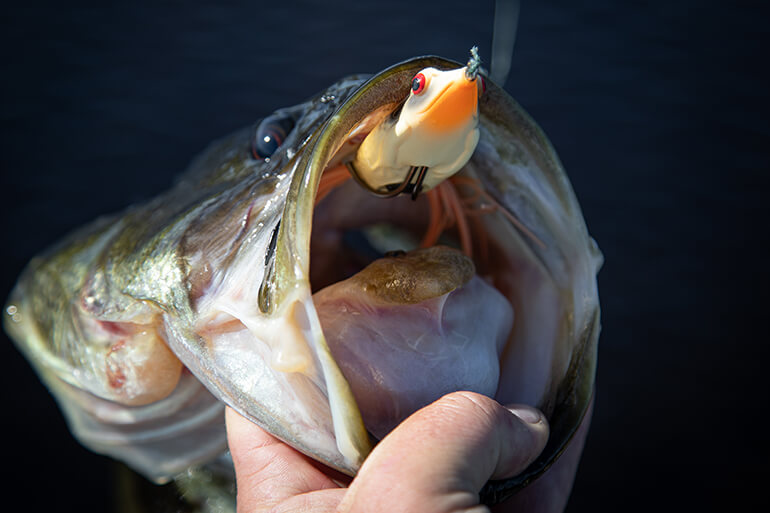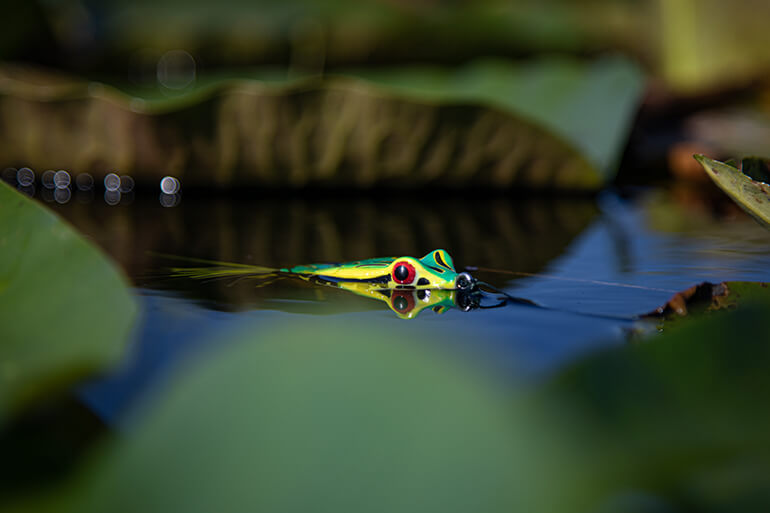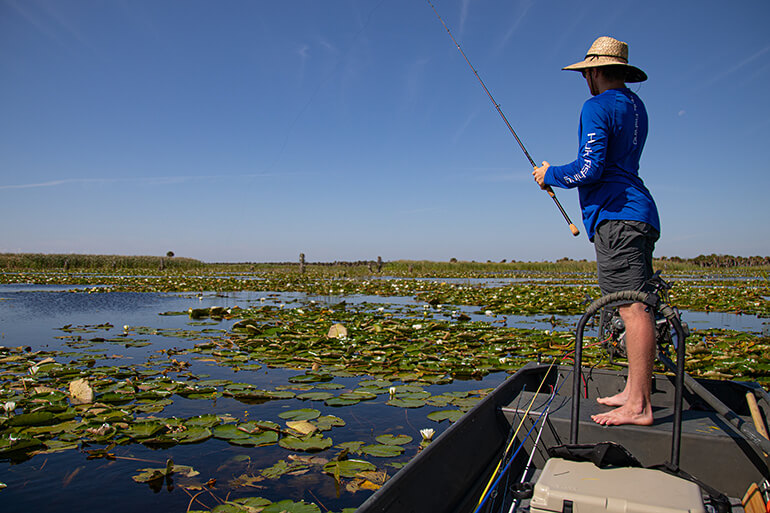
A hollow bodied frog is the way to go in many Florida fresh waters.
You’ve heard the deep grunt of a pig frog, watched a southern leopard frog dart into a thicket, or had a southern cricket frog scurry across your toes as you made your way down the bank.
Those are dead giveaways to what lure you should tie on. A hollow body frog!
Frog lures are some of the best lures you can throw in Florida, because of the abundance of two things that go hand and hand: Frogs (a prime source of forage for Florida largemouth) and aquatic vegetation. Hydrilla, duckweed, bladderwort, lily pads, cattails, the list goes on: As we’ve all seen, this stuff can get thick, especially in the heat of summer, practically covering a lake at times. The frogs love it and so do the bass! It offers cover for both species. The weedless attributes of a hollow body frog allow you to fish it in the heaviest of vegetation, which is where you want it.
WALKIN’ OR POPPIN’

There are two types of hollow body frogs. One is the walking frog, with a flat keel that “walks,” similar to that of a topwater plug. There is also a popping frog, that has a cupped mouth that “pops.” On those calm mornings when the wind is down and the lake is slicked out, a walking frog may be your best bet, as it slips and slides its way through the vegetation, not making much racket. If the wind has picked up and you need to make a little more noise to help them find the bait, a popping frog is a go to. Often when fishing open water grass lines or when there are larger pockets in the vegetation. You can also walk these pretty well. A few of my favorite frogs being the Strike King KVD Sexy Frog and Spro Bronzeye Poppin’ Frog.
SLOW YOUR ROLL

I often see people fishing hollow body frogs way too fast. Bass can have a hard time keying in on a bait in the heavy vegetation, especially when it’s moving so fast. Cast and when it lands, let it just sit there for 10 seconds. You’d be surprised how many times you get blown up on without doing anything. This mimics a frog that has just jumped in the water and is trying to gather his marbles, per se. I’ll often cast my frog onto the bank and drag it back into the water and let it sit, too.
When working the frog back, you want to hit the holes and pockets in the vegetation. Once my lure is right on the edge, I like to slowly drag it into the opening and let it sit for a few seconds. I’ll then walk or pop it once and let it sit again. I’ll repeat this many times. Remember, the rubber legs are doing the work, as they sprawl out and move when the frog is stationary. Bass can’t stand it.
I’ll typically fish my frog in a pocket the size of a trash can lid for 30 seconds or so. It can get tedious, but you may draw a fish in from far away, that you would’ve missed if you were working the lure quickly.
THE RIGHT STICK

There are rods built specifically for frog fishing. These rods need two things, a light enough tip to cast hollow bodies, and the backbone to winch out a fish from the thickest of vegetation. One good example is the 7’2”, Lew’s Custom Speed Stick Magnum Frog rod. Pair it with a 7.5:1 ratio reel, spooled with 65-pound braid and you’re in the game.
The heavy braid is required to pull out the fish and all the vegetation you’re going to bring with it, plus, it can handle being dragged through the slop all day. Lock down that drag, when a fish eats, set up and don’t stop reeling until it’s out of the cover, you want to keep its head up. If you don’t, the fish will sound into the vegetation and chances are it will be lost.
FROG MODS

One thing to try is to trim the rubber legs some. This can help your hookup ratio, as a bass has less of a chance of short striking the lure and just eating the legs. Also, trimming one leg shorter than the other can help the frog walk better.
You might stick three or four BBs into the body through the hook opening, to add a little noise and weight it to sit lower in the water, making it easier for the bass to get it when they’re not committing. This will cause your frog to fill with water a little faster, so remember to squeeze it out every couple of casts.
Tip: When they do blow up on your frog, let them eat it! Wait a couple of seconds before setting the hook to make sure they have it. FS
Published Florida Sportsman Magazine June 2021












